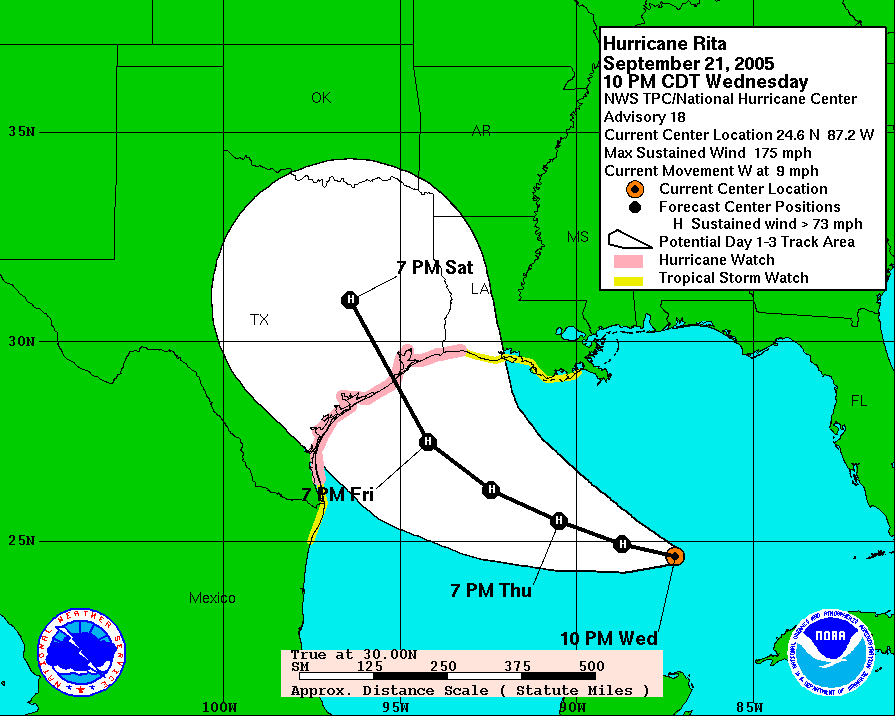Hurricane heroes —
It would have been hell for a sprawling city already in the grips of a pandemic.
Eric Berger
–

Enlarge / In parts of the city, traffic moved during the Rita evacuation.
F. Carter Smith/Bloomberg via Getty Images
HOUSTON—Jeffry Evans’ mobile phone rang shortly before 3am, local time, instantly waking him from a deep slumber.
Not good, he instinctively knew.
The Houston meteorologist had crashed late on Monday, August 24. Before hitting the mattress around midnight, he left instructions to be awakened if the forecast for Hurricane Laura took a turn for the worse. And now it had. By early Tuesday, the overnight model guidance indicated a high probability the storm may take a more westerly track across the Gulf of Mexico and strike the fourth-largest US city.
Evans serves as “meteorologist in charge” of the National Weather Service office that covers the Houston-Galveston region, which has a population well north of 7 million. One of the forecasters at his office had just been briefed by the National Hurricane Center. Concerns were rising about a strike near Houston.
So Evans rubbed his eyes as he checked the forecast models for himself, at home, in the middle of the night. As he reviewed the latest data, the outlook appeared pretty grim. The world’s best forecast model, run by a Europe-based organization, projected a landfall near Houston. Moreover, its ensemble suite, which provides broader perspective, showed a landfall farther south. This represented pretty much the worst-case scenario for the largest city on the Gulf of Mexico.
Houston would lie to the right of such a landfalling hurricane, taking the full force of its screaming winds and watching neighborhoods flatten. Massive waves would roll into Galveston Bay and, from there, funnel into the Houston Ship Channel. There, barely a dozen feet above sea level, large refineries process about 15 percent of the nation’s petroleum. Countless other chemical companies also have facilities along the waterway. The economic and environmental catastrophe would be almost beyond calculation.
Evans also thought about his own situation. He lived near the National Weather Service office, which is located a few miles from Galveston Bay. Evans spared a few minutes to consider how best to prepare his home for the worst, and whether his wife and their 40- and 80-pound dogs should evacuate.
After quickly assessing the forecast, Evans picked up his cell phone and texted Jeff Lindner, the lead forecaster at Harris County Flood Control District. Evans wanted to make sure officials at Harris County knew what was happening and understood the heightened threat faced by the community.
Houston is located in Harris County, and its chief executive, the “County Judge,” has the final say on local evacuations. A 29-year-old politician named Lina Hidalgo had surprisingly been elected to the position in 2018 after the formerly Republican county turned Democratic. This was her first hurricane. Now, the untested leader would be called upon to make the final evacuation decision.
Until Tuesday morning, it seemed that Houston probably would be spared the worst from Laura, but now Evans was not so sure. The hurricane would make landfall in less than 48 hours, cutting it close for the time needed to get hundreds of thousands of people away from the coast. Worse, Houston has a bad history with evacuations. Were an evacuation called, inland residents who did not need to flee might do so anyway, clogging roads for those who really needed to go. That had happened before. And if the National Hurricane Center was going to predict a landfall near Houston, that very well might precipitate an exodus.
Hidalgo had important decisions to make, and so Evans sent his text to Lindner. It was short and sweet: “You up?”
The Rita nightmare
Houston experienced the nation’s worst hurricane evacuation 15 years ago, when a storm named Rita menaced the state in late September. In some ways, this was the perfect storm to terrify a city built dozens of miles inland and dozens of feet above sea level.
That’s because Rita was an alarming storm. Late on the evening of September 21, 2005, Rita intensified to 175mph over the central Gulf of Mexico, and it was forecast to make landfall a little more than two days later just below Houston on the Texas coast.
“This was the worst-case scenario for Houston,” said Bill Read, then the meteorologist-in-charge of the Houston/Galveston Office. He would go on to lead the National Hurricane Center for several years before retiring.

Hurricane Rita forecast for Sept 21, 2005, about 30 hours before landfall.
National Hurricane Center
Another factor that contributed to the mass evacuation was Hurricane Katrina, which had made landfall three weeks earlier near New Orleans. The storm killed more than 1,000 people and produced dramatic images of flood-stricken residents pleading for rescue from their homes. A quarter of a million people had evacuated from the region to Houston, and nearly all were still here.
Finally, local officials did a poor job of messaging the need to “run from the water, and hide from the wind.” This basically means that residents of coastal areas need priority to evacuate first, due to their vulnerability to life-threatening storm surge. But this was not what then-Houston Mayor Bill White said a little less than three days before Rita made landfall. Instead, White urged his city to run for the hills, saying, “Don’t wait. The time for waiting is over.”
Houston didn’t wait. More than 3 million people got into their cars or onto hastily arranged school buses. These vehicles took to the roads. And then the region’s freeways and highways, for more than 100 miles on the routes to Dallas, Austin, San Antonio, and elsewhere, came to a standstill. As they baked in their cars, beneath 100-degree heat, desperate drivers eventually turned off their AC to conserve fuel. Many ran out of gas anyway, and roadside stations were quickly depleted.
The roads turned deadly. Normal three- or four-hour drives from Houston to other major Texas cities took 20 hours or more. A total of 67 people died due to heat stress, and 23 nursing home evacuees were killed in a bus fire. All told, an estimated 107 people died during this nightmare evacuation.
In the early morning hours of Thursday, Sept. 22, 2005, traffic is backed up as people leave the Houston area in anticipation of Hurricane Rita.
Ken Cedeno/Corbis via Getty ImagesVehicles jam the northbound lanes (R) of I-45 as the southbound lanes (L) are empty on September 22, 2005. The region had no plans to open contraflow lanes at the time.
STAN HONDA/AFP via Getty ImagesEvacuees line up to board a bus at the Island Community Center September 21, 2005 in Galveston, Texas. But it wasn’t just coastal residents who fled during Rita. Everyone did.
Dave Einsel/Getty ImagesAirports were flooded with people. Lines of passengers wait at a security checkpoint on September 22, 2005, before flying out of George Bush Intercontinental Airport in Houston, Texas.
STAN HONDA/AFP via Getty ImagesIn parts of the city, traffic moved during the Rita evacuation.
F. Carter Smith/Bloomberg via Getty ImagesBut most of the time it was gridlock.
Dave Einsel/Getty ImagesDuring a mandatory evacuation, nursing homes, hospitals, and prisons must also be evacuated. It is a logistical nightmare.
Dave Einsel/Getty ImagesSchool buses: They’re not just for school any more.
JAMES NIELSEN/AFP via Getty Images
Rita ended up weakening more than forecasters expected after its inner core disintegrated. And much like Hurricane Laura, it approached the Texas coast and then turned north, making landfall near the state’s border with Louisiana. Houston ended up with a glancing blow and memories of the worst hurricane evacuation of all time.
Since then, the region has learned some lessons. Its leaders understand the difference between evacuating coastal areas and regions well inland. However, local residents also remember Hurricane Ike, which came ashore in 2008 just east of Houston. It knocked out power for weeks. The threat of lost power, alone, would impel many inland residents to evacuate again, said Bob Stein, a political scientist at Rice University.
Finally, Houston has grown substantially since Rita. The Houston metro area population at the time was about 5 million, with the vast majority living in Harris County. By the time Hurricane Laura threatened the city, the metro population had grown by 40 percent. Houston’s freeway lanes have not grown nearly as fast. Trying to get as many people out of the area, in less time, would be an unmitigated disaster.

